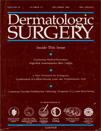A New Treatment for Syringoma
Combination of Carbon Dioxide Laser and Trichloroacetic Acid
Abstract
background
Although syringoma represents a benign tumor of skin appendage, multiple and diffuse facial lesions can cause cosmetic problems for the affected individuals. Scarring, recurrence and postinflammatory hyperpigmentation can be serious troubles, especially for oriental people receiving various therapeutic modalities.
objective
The purpose of this study was to evaluate the histopathologic and clinical efficacy of a new therapeutic approach for syringoma, consisting of combination of carbon dioxide (CO2) laser and 50% trichloroacetic acid (TCA).
methods
Eighty skin biopsy specimens (45 patients) were evaluated to determine the depth of syringoma lesion. Among these, 28 specimens were obtained after a single test-pulse of CO2 laser (focused, superpulsed mode, power setting of 0.7–2 watts, beam diameter of 0.1 mm, pulse duration of 0.1 seconds), and 3 specimens after one pass of CO2 laser and 50% TCA. The depths of laser-induced vaporization and TCA-induced tissue necrosis were measured. Twenty patients were treated with the combination therapy of CO2 laser (two passes of laser) and 50% TCA. Clinical effectiveness and complications of combination therapy were evaluated by direct observation and photographs.
results
Tumor depth: Analysis of eight specimens revealed tumor depth of 0.70 ± 0.20 mm (mean ± SD), ranging from 0.4 ~ 1.2 mm. There were no correlations between tumor depth and age of onset or duration of the tumor. Laser penetration depth: CO2 laser irradiation, 0.7 ~ 2 watts, induced vaporization of 0.29 ± 0.12 mm in depth with carbonized rim of 0.1 ± 0.03 mm width (n = 28 from 15 patients). With laser power of 1 watt, vaporization ranged from 0.17 ~ 0.45 mm in depth. Laser and TCA induced necrosis: TCA application resulted in extra tissue necrosis of 0.22 ~ 0.25 mm in depth beyond the level achieved by laser vaporization. Clinical Findings: Among the 20 patients treated with the combination therapy, therapeutic effect for 11 patients was excellent, 6 patients showed good clinical response, and 3 patients were fair. There were no serious complications resulting from this procedure such as infection, scarring or textural change.
conclusion
The application of 50% TCA after CO2 laser irradiation was effective for removing deep-seated syringoma cells and for reducing the side effects, especially scarring. To the best of our knowledge, this is the first study introducing the combination of CO2 laser and TCA for removal of syringoma.




